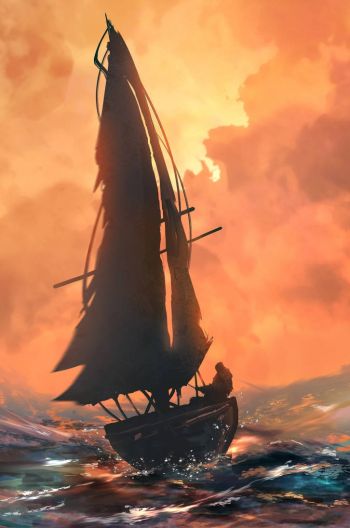Difference between revisions of "Sailing (sage ability)"
Tao alexis (talk | contribs) |
Tao alexis (talk | contribs) |
||
| Line 57: | Line 57: | ||
== Authority == | == Authority == | ||
| − | ''to be added' | + | ''to be added'' |
[[Category: Expand Abilities]] | [[Category: Expand Abilities]] | ||
Revision as of 21:53, 21 September 2020
Sailing is a sage ability that employs the wind, acting on sails, to propel a craft on the surface of the water over a chosen course, which is often part of the larger plan of navigation. Like all athletic abilities, the amount of ability is ranked according the character's total knowledge, which is graded as no skill, insufficient skill, amateur, authority, expert and sage "status."
No Skill
Those with zero knowledge cannot perform the ability in any degree at all, even as helpers aboard ship, except to bail. Such persons may be minimally trained to reach an "insufficient" skill, provided their teacher has (1) an authority-status in sailing; or (b) both amateur-status in sailing and the sage ability, give secondary skill.
By either of these, the student may, after 17 hours of continuous sailing and working aboard ship, make an attempt to gain 1 point of sailing ability. This requires a successful intelligence check and wisdom check. If either check fails, another 17 hours of training must follow before the attempt to learn a point can be made again. No more than three successes are possible per month of training, while a maximum of 9 points may be gained (1 less than is needed for amateur status).
To achieve amateur status, the teacher must have both an authority-status ability in sailing and the pass along ability sage ability.
Insufficient Skill
Characters with a bare minimum of knowledge who are not yet amateurs can provide assistance as "supportive crew" in up to "moderate breeze conditions," or 16 knots. Above that, those with insufficient skill can find themselves overwhelmed, each hour under such conditions, they will need to make a fault check.
Calculating a fault check for supportive crew equals 7% per point of dexterity above 10, plus their own sailing knowledge, plus the knowledge of their captain. A subtraction is applied when the force of the wind is above 5 (fresh breeze) equal to the square of the wind rating minus 1. Any number above this percentage will require a roll on the Fault Chart, below.
For example, a supportive crewman with a 17 dexterity and 4 points of knowledge in sailing, would have a 53% base chance of success; if the captain had 16 points of knowledge, this would increase the support crew to 69%. This is what it would be in a fresh breeze; in a "strong breeze" (rating-6) it would be -25%; in a "near gale" (rating-7) it would be -36%; and in a "gale" (rating-8) it would be -49%.
Persons with this status of ability will not be able to manage a boat on their own, nor properly be able to teach others how to sail.
Amateur
Characters with amateur-status will have complete knowledge of how a sailing vessel is intended to work and how to manage up to 3 supportive crew competently. They will not be able to master boats that ask for more than 4 crew members by themselves, as these will require at least one sailor with authority-status. However, amateurs will be able to handle any lesser boat by themselves if necessary in up to "fresh breeze conditions," or 21 knots. In worse conditions, amateurs must make a fault check every hour.
| Roll | Error | Result |
|---|---|---|
| 01-07 | boom strike | hit by swinging boom, 1-6 damage; on boats less than 5 tons, roll dex check or be knocked overboard |
| 08 | broach | cause a dangerous broach leading to a capsize |
| 09-10 | damage critical part | vessel drifting; part cannot be repaired |
| 11-14 | damage major part | vessel drifting until 2-5 hours repair applied |
| 15-25 | damage minor part | vessel drifting until 20-80 minutes repair applied |
| 26-32 | fall overboard | no check, slip and fall into the water, no check possible |
| 33-42 | falter on bailing | amidst stress and duties, failure to bail threatens vessel |
| 43-50 | hypothermia | requires treatment to continue sailing |
| 51-59 | injury | slip or fall; 2-5 pts. of injury ends usefulness as support crew; halves new fault checks for amateur and above |
| 60-71 | lose course | become aware that the vessel's position has become uncertain |
| 72-81 | run aground | occurs only in waters where this is possible |
| 82-00 | slip or crash | accident causes 1-4 damage |
Calculating a fault check for amateur-status equals 9% per point of dexterity above 8, plus sailing knowledge, plus their own sailing knowledge, plus the combined knowledge of up to three supportive crew on board (the best crew members are counted). A subtraction is applied when the force of the wind is above 6 (fresh breeze) equal to the square of the wind rating minus 2. Any number above this percentage will require a roll on the Fault Chart.
For example, an amateur sailor with a 12 dexterity and 16 points of knowledge in sailing, would have a 52% base chance of success; if the counted supportive crew had 9 points, this would increase the rating to 61%. This is what it would be in a strong breeze; in a "near gale" (rating-7) it would be -25%; in a "gale" (rating-8) it would be -36%; and in a "strong gale" (rating-9) it would be -49%.
Persons with this status of ability will not be able to teach sailors without the sage ability, give secondary skill.
Authority
to be added
